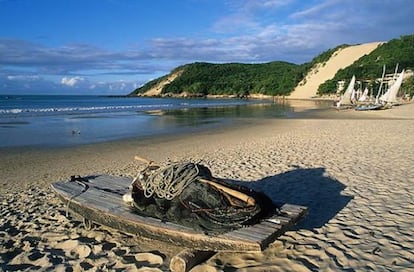Brazil failing to lure tourists despite its many attractions
Only six million visit the South American nation annually compared to 53 million who come to Spain


It is difficult to find anyone in any corner of the world who doesn’t dream of one day visiting Brazil. At least 98 percent of those who do come leave with the promise to return, according to Brazil’s Tourism Ministry.
So why has Brazil recently been receiving lower numbers of foreign tourists?
The figures show that last year tourism grew by six percent, perhaps because of the interest drummed up by the World Cup, which kicks off in June, and the 2016 Olympic Games. But that figure represents fewer than six million people, 1.5 million of whom come from neighboring Argentina.
Brazil has some astonishing attractions to offer: 8,000 kilometers of beaches, most of them pristine and deserted; forests, such as the Amazon rainforest, considered some of the most important and beautiful sanctuaries in the world; Portuguese colonial cities such as Ouro Preto, Diamantina and Tiradentes, with their baroque architecture; and, of course, the metropolises of Rio de Janeiro and Salvador Bahía.
According to experts, Brazil has the potential to bring in around 40 million people annually but, despite the government’s efforts in the past several years, doing so is far from easy; even despite the work of charismatic former president Luiz Inácio Lula da Silva, who knew better than anyone how to sell his country abroad.
Among 133 nations, Brazil ranks second in terms of the best ecotourism opportunities and 14th on the list of the nations with the high number of cultural activities. The country fails to achieve an entry in Travel+Leisure’s list of the top 50 tourist attractions around the world. However, Mexico is present with its capital’s main Zócalo square.
With half the population of Brazil and four-and-a-half-times smaller, Mexico received four times as many visitors (23 million) than the South American giant in 2012.
The figures compiled by the World Tourism Organization are much more dramatic if they are compared not just with numbers for the United States, but also with those for Europe. Although 98 times smaller than Brazil, Portugal welcomes one million more tourists (7.2 million) annually. Spain, a country that 56.7 million people visit annually, is 16 times smaller than Brazil and has five times fewer inhabitants.
The fact that Brazil is a long way from Europe is not to blame. China and Australia receive more European tourists than Brazil.
Europeans who visit Brazil are struck by the friendliness and helpfulness of its people. Although they rarely complain how far the country is from the old continent, they do think that some of Brazil’s spectacular natural wonders are a long way from the large cities.
Some years back I wrote a column for the travel section of EL PAÍS about a small corner of paradise in the northeast part of the country called Itaparatinga, in Alagoas state, where the beaches are crystal blue and where you can easily see white coral reefs. It wasn’t easy to get to; from Rio the entire trip took one full day. I wrote the report and some months later I returned to Itaparatinga. When I woke up, I was told that two youths from Madrid had lost their way so I went to go speak with them.
“We read your report and couldn’t resist,” they told me. I asked them if they regretted their decision. “No, because it is very beautiful,” they said, pledging they would one day return.
If Brazil, with its natural beauty, cannot attract more tourists, it is not because those who return to their home are not surprised, happy and gratified over what the country has to offer.
So why don’t more tourists come?
Tu suscripción se está usando en otro dispositivo
¿Quieres añadir otro usuario a tu suscripción?
Si continúas leyendo en este dispositivo, no se podrá leer en el otro.
FlechaTu suscripción se está usando en otro dispositivo y solo puedes acceder a EL PAÍS desde un dispositivo a la vez.
Si quieres compartir tu cuenta, cambia tu suscripción a la modalidad Premium, así podrás añadir otro usuario. Cada uno accederá con su propia cuenta de email, lo que os permitirá personalizar vuestra experiencia en EL PAÍS.
¿Tienes una suscripción de empresa? Accede aquí para contratar más cuentas.
En el caso de no saber quién está usando tu cuenta, te recomendamos cambiar tu contraseña aquí.
Si decides continuar compartiendo tu cuenta, este mensaje se mostrará en tu dispositivo y en el de la otra persona que está usando tu cuenta de forma indefinida, afectando a tu experiencia de lectura. Puedes consultar aquí los términos y condiciones de la suscripción digital.
Últimas noticias
Most viewed
- Reinhard Genzel, Nobel laureate in physics: ‘One-minute videos will never give you the truth’
- Pablo Escobar’s hippos: A serious environmental problem, 40 years on
- Charles Dubouloz, mountaineering star, retires at 36 with a farewell tour inspired by Walter Bonatti
- Why we lost the habit of sleeping in two segments and how that changed our sense of time
- The Florida Keys tourist paradise is besieged by immigration agents: ‘We’ve never seen anything like this’








































